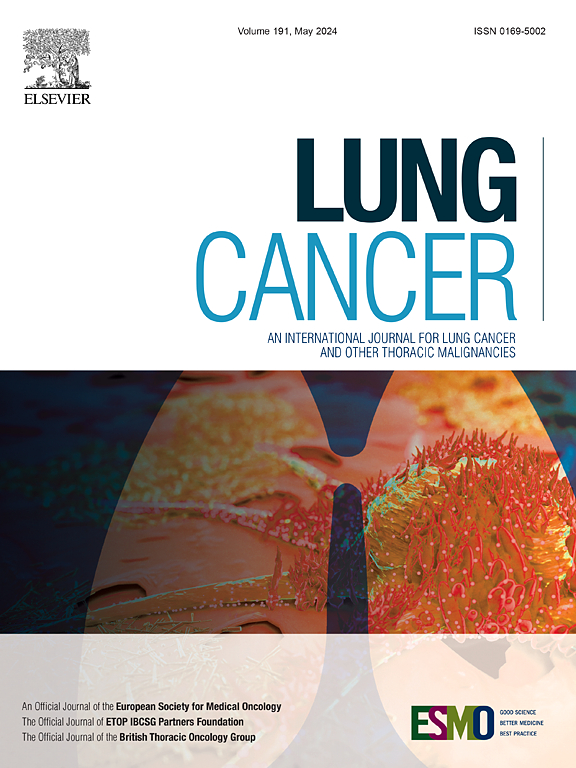Transforming lung cancer diagnosis: the role of robotic-assisted bronchoscopy in early detection and staging
IF 4.4
2区 医学
Q1 ONCOLOGY
引用次数: 0
Abstract
Introduction
Minimally invasive techniques, including CT-guided transthoracic biopsy (CTTB) and robotic-assisted bronchoscopy (RAB), play a crucial role in diagnosing peripheral pulmonary lesions suspected of lung cancer. This article aims to assess differences in primary lung cancer diagnosis and staging between patients undergoing ssRAB with shape-sensing RAB (ssRAB) and CTTB.
Methods
This retrospective cohort study included 407 patients who underwent CTTB (2017–2020) and 556 who underwent ssRAB (2020–2023) at a single institution. Propensity score matching (1:1) was applied to balance baseline covariates. Outcomes included cancer stage at diagnosis, procedural safety, and hospital metrics. Logistic regression and descriptive statistics were used to analyze differences.
Results
After matching, 148 patients per group were analyzed. Patients in the ssRAB group were more frequently diagnosed at an early stage compared to the CTTB group (OR = 3.02, 95 % CI: 1.83–5.04, p < 0.001). ssRAB demonstrated significantly lower rates of pneumothorax (3.38 % vs. 44.59 %, p < 0.001) and hospital admissions (5.41 % vs. 19.59 %, p < 0.001). Despite longer procedural times, ssRAB reduced hospital stays by 34 min (p < 0.001). Diagnostic yield for malignancy was comparable between ssRAB and CTTB (86.48 % vs. 89.18 %, p = 0.594).
Conclusion
ssRAB significantly improves early-stage lung cancer detection and reduces procedural risks, offering a safer, patient-centered approach. Its integration into diagnostic pathways represents a transformative advancement in lung cancer care. Further studies are warranted to confirm its broader impact across diverse healthcare settings.
改变肺癌诊断:机器人辅助支气管镜在早期发现和分期中的作用
包括ct引导下的经胸活检(CTTB)和机器人辅助支气管镜检查(RAB)在内的微创技术在诊断疑似肺癌的周围肺病变中起着至关重要的作用。本文旨在评估形状传感RAB (ssRAB)和CTTB接受ssRAB的患者在原发性肺癌诊断和分期方面的差异。方法本回顾性队列研究包括407例CTTB患者(2017-2020)和556例ssRAB患者(2020-2023)。采用倾向评分匹配(1:1)来平衡基线协变量。结果包括诊断时的癌症分期、手术安全性和医院指标。采用Logistic回归和描述性统计分析差异。结果配对后,每组分析148例。与CTTB组相比,ssRAB组患者在早期诊断的频率更高(OR = 3.02, 95% CI: 1.83-5.04, p <;0.001)。ssRAB组气胸发生率明显降低(3.38% vs. 44.59%, p <;0.001)和住院率(5.41% vs. 19.59%, p <;0.001)。尽管手术时间较长,但ssRAB减少了34分钟的住院时间(p <;0.001)。ssRAB和CTTB对恶性肿瘤的诊断率相当(86.48%对89.18%,p = 0.594)。结论rab可显著提高早期肺癌的检出率,降低手术风险,是一种更安全、以患者为中心的方法。将其整合到诊断途径中代表了肺癌治疗的变革性进步。有必要进一步研究以证实其在不同医疗保健环境中的广泛影响。
本文章由计算机程序翻译,如有差异,请以英文原文为准。
求助全文
约1分钟内获得全文
求助全文
来源期刊

Lung Cancer
医学-呼吸系统
CiteScore
9.40
自引率
3.80%
发文量
407
审稿时长
25 days
期刊介绍:
Lung Cancer is an international publication covering the clinical, translational and basic science of malignancies of the lung and chest region.Original research articles, early reports, review articles, editorials and correspondence covering the prevention, epidemiology and etiology, basic biology, pathology, clinical assessment, surgery, chemotherapy, radiotherapy, combined treatment modalities, other treatment modalities and outcomes of lung cancer are welcome.
 求助内容:
求助内容: 应助结果提醒方式:
应助结果提醒方式:


